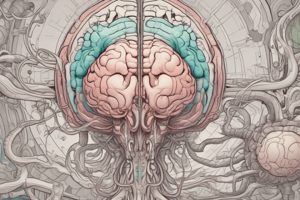Podcast
Questions and Answers
Which of the following structures connects the third ventricle to the fourth ventricle?
Which of the following structures connects the third ventricle to the fourth ventricle?
- Foramina of Luschka
- Cerebral aqueduct (correct)
- Interventricular foramen
- Foramina of Magendie
In which part of the brain are the lateral ventricles located?
In which part of the brain are the lateral ventricles located?
- Rhombencephalon
- Cerebral hemispheres (correct)
- Brainstem
- Diencephalon
Which of the following is NOT a function of cerebrospinal fluid?
Which of the following is NOT a function of cerebrospinal fluid?
- Regulation of body temperature (correct)
- Removal of waste products
- Maintenance of the blood-CSF barrier
- Buoyancy and cushioning of the brain
What is the main function of the arachnoid villi in cerebrospinal fluid circulation?
What is the main function of the arachnoid villi in cerebrospinal fluid circulation?
Where is cerebrospinal fluid produced?
Where is cerebrospinal fluid produced?
What is the shape of the fourth ventricle?
What is the shape of the fourth ventricle?
Which ventricle is responsible for producing cerebrospinal fluid and contains the hypothalamus and thalamus?
Which ventricle is responsible for producing cerebrospinal fluid and contains the hypothalamus and thalamus?
Which of the following ventricles has five distinct parts?
Which of the following ventricles has five distinct parts?
What drives the circulation of cerebrospinal fluid through the ventricles and central canal of the spinal cord?
What drives the circulation of cerebrospinal fluid through the ventricles and central canal of the spinal cord?
Which structure receives cerebrospinal fluid from the lateral and third ventricles?
Which structure receives cerebrospinal fluid from the lateral and third ventricles?
What is the main function of cerebrospinal fluid in relation to the brain?
What is the main function of cerebrospinal fluid in relation to the brain?
Which of the following is a result of the circulation of cerebrospinal fluid?
Which of the following is a result of the circulation of cerebrospinal fluid?
Flashcards are hidden until you start studying
Study Notes
Ventricles of the Brain
Lateral Ventricles
- Located in the cerebral hemispheres
- Largest ventricles in the brain
- Divided into anterior, posterior, and inferior horns
- Communicate with the third ventricle through the interventricular foramen (of Monro)
Third Ventricle
- Located in the diencephalon
- Narrow, slit-like ventricle
- Connects with the lateral ventricles through the interventricular foramen (of Monro)
- Connects with the fourth ventricle through the cerebral aqueduct (of Sylvius)
Fourth Ventricle
- Located in the rhombencephalon (hindbrain)
- Pyramid-shaped ventricle
- Connects with the third ventricle through the cerebral aqueduct (of Sylvius)
- Contains the obex and the calamus scriptorius
- Cerebrospinal fluid (CSF) flows out of the fourth ventricle through the foramina of Luschka and Magendie
Cerebrospinal Fluid Circulation
- Produced by the choroid plexus in the ventricles (~500-700 mL/day)
- Flows from the lateral ventricles to the third ventricle to the fourth ventricle
- Exits the fourth ventricle through the foramina of Luschka and Magendie
- Circulates through the subarachnoid space surrounding the brain and spinal cord
- Absorbed into the bloodstream through the arachnoid villi
- Plays a crucial role in:
- Buoyancy and cushioning of the brain
- Removal of waste products
- Regulation of intracranial pressure
- Maintenance of the blood-CSF barrier
Ventricles of the Brain
Lateral Ventricles
- Located in the cerebral hemispheres, largest ventricles in the brain
- Divided into anterior, posterior, and inferior horns
- Communicate with the third ventricle through the interventricular foramen (of Monro)
Third Ventricle
- Narrow, slit-like ventricle located in the diencephalon
- Connects with the lateral ventricles through the interventricular foramen (of Monro)
- Connects with the fourth ventricle through the cerebral aqueduct (of Sylvius)
Fourth Ventricle
- Pyramid-shaped ventricle located in the rhombencephalon (hindbrain)
- Connects with the third ventricle through the cerebral aqueduct (of Sylvius)
- Contains the obex and the calamus scriptorius
- Cerebrospinal fluid (CSF) flows out of the fourth ventricle through the foramina of Luschka and Magendie
Cerebrospinal Fluid Circulation
- Produced by the choroid plexus in the ventricles at a rate of ~500-700 mL/day
- Flows from the lateral ventricles to the third ventricle to the fourth ventricle
- Exits the fourth ventricle through the foramina of Luschka and Magendie
- Circulates through the subarachnoid space surrounding the brain and spinal cord
- Absorbed into the bloodstream through the arachnoid villi
- Maintains buoyancy and cushioning of the brain
- Removes waste products
- Regulates intracranial pressure
- Maintains the blood-CSF barrier
Ventricles of the Brain
Third Ventricle
- Located in the diencephalon, between the thalamus' two halves
- Connected to lateral ventricles through interventricular foramina
- Houses hypothalamus and thalamus
- Produces cerebrospinal fluid (CSF)
Lateral Ventricles
- Situated in the cerebral hemispheres
- Largest ventricles in the brain
- Comprise five parts: anterior horn, body, posterior horn, occipital horn, and temporal horn
- Communicate with the third ventricle through interventricular foramina
- Produce cerebrospinal fluid (CSF)
Fourth Ventricle
- Located in the rhombencephalon, between the cerebellum and the pons
- Connected to the spinal cord's central canal through the cerebral aqueduct
- Produces cerebrospinal fluid (CSF)
- Receives CSF from the lateral and third ventricles
Cerebrospinal Fluid Circulation
- Produced by the choroid plexus in the ventricles
- Circulates through the ventricles and the spinal cord's central canal
- Flows from lateral ventricles → third ventricle → fourth ventricle → central canal of the spinal cord
- Absorbed into the bloodstream through the arachnoid villi
- Driven by the brain's pulsatile flow and the choroid plexus' movement
- Crucial for maintaining intracranial pressure, buoying the brain, and removing waste products
Studying That Suits You
Use AI to generate personalized quizzes and flashcards to suit your learning preferences.




